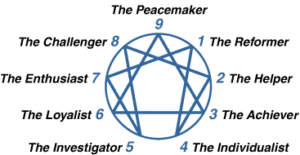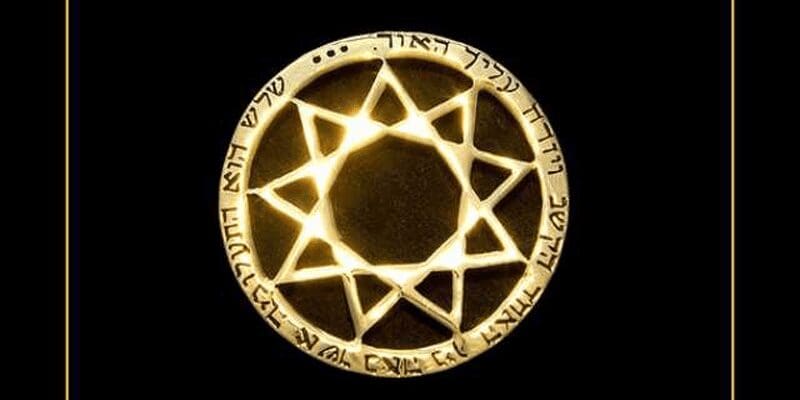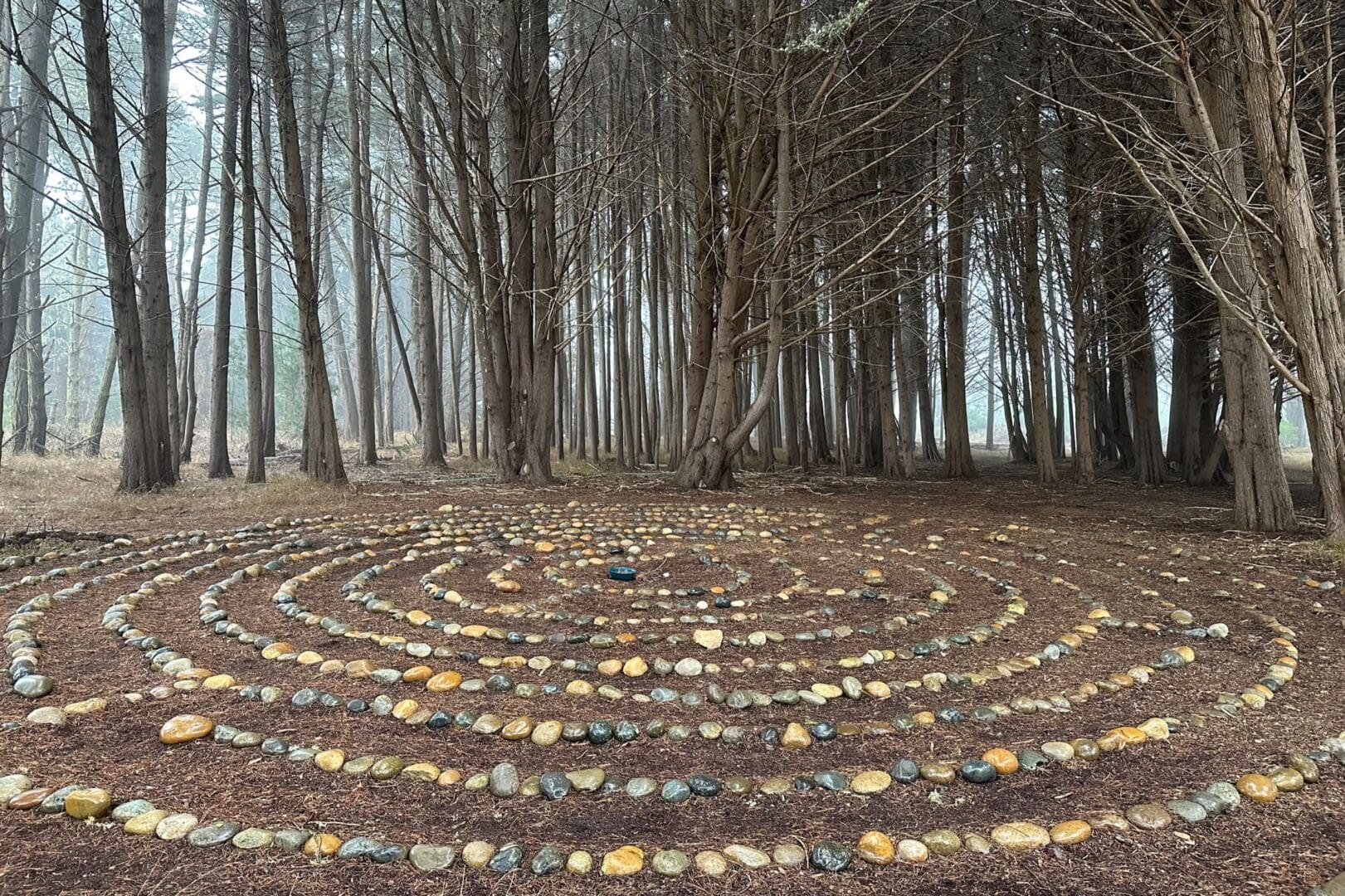I’m reading a slender volume by Claudio Narano—Ennea-Type Structures: Self Analysis for the Seeker. Naranjo is a Chilean psychiatrist, now in his 80s, who lives in Berkeley. He is a founding interpreter of the enneagram of personality. He was a close friend of Carlos Castaneda, a pioneer of entheogenic studies, and one of three named successors to Fritz Perls, the founder of Gestalt Therapy.
Naranjo learned the enneagram from Oscar Ichazo, the Bolivian-born founder of the Arica School.
The Enneagram Institute website is an excellent starting place to learn enneagram. Here is its historical section.
Enneagram was brought to the West by G.I. Gudjieff, the Armenian-Greek spiritual teacher and founder of Fourth Way studies.
 Ichazo denied his work derived from Gurdjieff. He said he found enneagram independently in his own travels. Gurdjieff’s students likewise distance themselves from the Ichazo-Naranjo tradition of the enneagram of personality. Gurdjieff never taught an enneagram of personality. Nevertheless, Gurdjieff famously showed students how to discover their “chief feature,” a distinctly characterological concept. Many leading thinkers in the Ichazo-Naranjo tradition do not shy away from making the link that both Gurdjieffians and Ichazo denied.
Ichazo denied his work derived from Gurdjieff. He said he found enneagram independently in his own travels. Gurdjieff’s students likewise distance themselves from the Ichazo-Naranjo tradition of the enneagram of personality. Gurdjieff never taught an enneagram of personality. Nevertheless, Gurdjieff famously showed students how to discover their “chief feature,” a distinctly characterological concept. Many leading thinkers in the Ichazo-Naranjo tradition do not shy away from making the link that both Gurdjieffians and Ichazo denied.
Naranjo brought enneagram to Berkeley. He taught it as a secret practice to circles of students who include many of the foremost enneagram of personality interpreters. When his students broke the circle of secrecy, Naranjo began to write about enneagram himself.
Naranjo added enormously to the original work on the enneagram of personality that Ichazo did. I wonder why enneagram has not had a deeper impact in archetypal psychology. It certainly has a popular following. Many who use it have no interest in its spiritual roots. Many use it for organizational team building. It found a home in divinity schools and, perhaps especially, in certain Catholic traditions, like that of Richard Rohr, whose book on the enneagram is a delight.
But enneagram hasn’t been afforded the respect that James Hillman and others in post-Jungian archetypal psychology have received. I suspect a certain Euro-American bias may be at work. How, this bias implies, could anything psychologically and spiritually serious come out of Latin America? Many other Latin American figures suffer from the same prejudice.
On the merits, enneagram is something deeply serious for archetypal psychology. We ignore at our peril the profound cultural connections between Latin America and Europe. Latin American thinkers hold a secret double advantage. First, they write from the “periphery”—where much of the best thought comes from. Second, they have a deeper immersion in the European traditions than we have in the United States.
Naranjo was born to a deeply cultured Arab/Moorish, Spanish, and Jewish family. His mother held salon-like gatherings for leading musical, literary, philosophical, and artistic figures. His depth of reference far exceeds that to which most of us have access.
An autobiographical interlude
I have been interested in human character all my life. My father was a political philosopher. My mother was a psychologist. In college and graduate school I studied psychology and politics. I wrote my doctoral dissertation on a group of Yale students with political ambitions. I served as recording secretary to the Wellfleet Psychohistorical Conference on Cape Cod in the early 1970s where some of the most creative psychological thinkers of that time—Erik Erikson, Robert Lifton, Kenneth Keniston, and Phillip Rieff—gathered. I seriously contemplated becoming a lay psychoanalyst. I underwent five years of daily psychoananlysis with a classically trained Freudian psychoanalyst. I volunteered at the Yale Psychiatric Institute. I had a joint appointment in the Yale department of political science and the medical school where my mentor, Kenneth Keniston, was based. Keniston was a psychologist who wrote Young Radicals and The Uncommitted about two generations of young people. Psychology and politics defined my education through college and graduate school.
I came to California in 1972, and in 1973 co-founded Full Circle, a residential treatment center outside Bolinas where we hoped to study the role of nutrition in the learning and behavior disorders of children. I founded Commonweal in 1976. My vision of Commonweal—which came to my as I looked at the site from a dirt road at the edge of Bolinas—was of a center for healing ourselves and healing the earth. That was simply transformed language for psychology and politics: healing ourselves and healing the earth. Within Commonweal, the projects I focused on shared one or both of these polarities: the Cancer Help Program, Healing Circles, the Collaborative on Health and the Environment, the Commonweal Sustainable Futures Group, and The New School at Commonweal have been vehicles for exploring soul and psyche, people and planet.
My trajectory was from Freud and the neo-Freudians as an undergraduate to the developmental psychologists in graduate school—Erik Erikson, Jean Piaget, and Lawrence Kohlberg. With Keniston, I overlaid the developmental schemas of Erikson, Piaget, and Kohlberg on each other.
Then came the 70s. I moved to California. I immersed myself in Carl Jung. After Jung, the first archetypal psychology to seize my interest, in about 1986, was Roberto Assagioli—the founder of Psychosynthesis. I was introduced to Assagioli by Rachel Naomi Remen, MD, co-founder of the Cancer Help Program, which we initiated at that time. Rachel was deeply trained in Psychosynthesis. Psychosynthesis remained my framework for understanding the psyche for many years.
My next big archetypal passion was James Hillman, the bad boy of archetypal psychologies. Hillman was the most brilliant student in Jung’s institute. A secular Jew and existentialist, he rebelled against Jung’s Christ-centered system. He turned Jung’s work upside down. A great starting place for studying Hillman is his acolyte Thomas Moore’s careful rendering of his work in A Blue Fire.
I studied Hillman’s work intensively. I did a series of New School conversations about him. I talked with Francis Weller about James Hillman. I talked with Hillman’s biographer Dick Russell. I had a remarkable conversation about Hillman with Pat Berry, Hillman’s ex-wife, who was deeply influential in the development of his work. I had several conversations with the West Marin philosopher John Gouldthorpe, who was deeply influenced by Hillman.
I never accepted Hillman’s rejection of the transpersonal psychologies. I could not accept his rejection of the ascentionist impulse—the psychologies that point to possible paths to evolution. At the same time, I embraced his awareness that our base instincts remain a living part of us. The ascentionist schools often lose site of our root chakras. I agree with Brother David Steindl-Rast, who said that the most alive people he ever met had lit up all their chakras—that we aren’t made to live just from the higher ones.
In the midst of this journey among the archetypal psychologies, I studied Jewish, Christian, Buddhist, yogic, and Sufi traditions. That is another story. Its relevance here is that spirit came to infuse my exploration of the human psyche.
One of my deepest experiences of psyche has been 31 years and 200 week-long retreats in the Commonweal Cancer Help Program. I co-lead these retreats with remarkable psychologists including Rachel Naomi Remen and Lenore Lefer—both deeply trained in psychosynthesis—as well as Stuart Horrance and Frances Weller—the latter deeply influenced by Hillman.
Consciousness expands at the expense of suffering, Jung said. Patanjali’s Yoga Sutras says: “the acceptance of our suffering as an aid to purification, the study of great wisdom teachings, and complete surrender to the divine force within us—these three things are yoga in practice.” That is a fundamental teaching for me.
Returning to enneagram
For years, I had no interest in enneagram. The fact that enneagram resisted me for years—or I resisted understanding it—is a critical part of this story. One day, perhaps three years ago, enneagram welcomed me in. It opened its doors of perception to me. I have been immersed in it for three years. It has profoundly influenced my understanding of myself and others.
Enneagram is not for everyone. Nor for every time in life. There was wisdom in Narnajo’s intent that it be a secret study. True enneagram remains a secret hidden in plain sight. Few are drawn to depth archetypal psychologies. Even fewer are drawn to depth work in enneagram. Depth enneagram is like the esoteric dimension of the religious traditions. The esoteric dimensions of these traditions remain a secret hidden in plain sight. These studies are for those who have eyes to see and ears to hear.
There are many enneagrams. One can chart, for each point, the passions and fixations, on the lower end, and the virtues and holy ideas as the higher end. One can chart the three sub-types at each point—self-preservation, social, and sexual—and therefore the 27 different character types that Beatrice Chestnut has so beautifully evoked in The Complete Enneagram. Chestnut follows Naranjo closely. Her book is a remarkable resource.
In addition to Chestnut’s book, and Richard Rohr’s book, and Naranjo’s work, I deeply admire A.H. Almaas’s Enneagram of Sacred Ideas. I also admire the two books on enneagram by Sandra Maitri, Almaas’s colleague in the Diamond Approach, The Spiritual Dimensions of the Enneagram and The Enneagram of Passions and Virtues. On the Gurdjieffian side, I have an intense admiration for a new and unheralded slender volume by Christian Wertenbaker, The Enneagram of G.I. Gurdjieff: Mathematics, Metaphysics, Music and Meaning. It should be required reading for anyone drawn to the extraordinary properties of this symbol.
Jung, Hillman, Assagioli’s Psychosynthesis and Enneagram
It is useful to contrast Jung, Hillman, Assagioli’s Psychosynthesis, and Enneagram. Jung, Assagioli, and Enneagram are all aspirational psychologies. Assagioli once said of Freud that his elevator went to the basement but not to the top floor. These aspirational psychologies all point to what we may be—and how difficult the struggle is to become what we may be.
Claudio Naranjo offers this telling footnote:
In this teaching, Protoanalysis constitutes the first stage in a process comprising the application of three successive methods. Beyond work of self-observation and confrontation which has self-insight as its goal, the work proceeds to a “holy war” [emphasis added] against the ego in which efforts are made to inhibit the compulsive aspects of the personality and to cultivate the virtue corresponding to the individual’s ruling passion. The third stage is of a contemplative nature, and is geared to an experiential understanding (through sophisticated techniques of meditation with an object) of the “Holy Ideas” aspects of reality that have the virtue of dissolving the individual’s fixation or implicit cognitive error. [Claudio Naranjo, Ennea-Type Structures: Self-Analysis for the Seeker].
James Hillman, by contrast, as I have said, abhorred “self-improvement” psychologies. He describes the function of the ego as that of a janitor banking or stoking the furnaces of the different archetypal structures. He describes the unconscious as a jungle we penetrate in order to see, but not unnecessarily to disturb, the fauna and flora.
Assagioli’s Psychosynthesis is deeply aspirational. Assagioli was a leading figure in the community around Alice Bailey and her esoteric spiritual teachings. He made a deliberate decision to separate his psychology from his esoteric spiritual beliefs. As a result, his psychology is schematic. His circle of consciousness, trisected into lower, middle and upper unconscious, shows a center point of consciousness surrounded by orbiting sub-personalities. But these sub-personalities are without specific content. For Jung, for Hillman, and for Enneagram, the sub-personalities or archetypes are filled with specific content. Assagioli doesn’t deny specific content—he just doesn’t fill it in.
What intrigues about enneagram is how accurate the nine character types are, how accurate the lines connecting the types are, and how accurate the three sub-types for each point (self-preservation, social, and sexual) are. Above all, I am fascinated by the correspondences with other traditions.
The Enneagram Institute website further elaborates:
Ichazo saw the Enneagram as a way of examining specifics about the structure of the human soul and particularly about the ways in which actual soul qualities of Essence become distorted, or contracted into states of ego. In developing his Enneagram theories, he drew upon a recurrent theme in Western mystical and philosophical tradition—the idea of nine divine forms. This idea was discussed by Plato as the Divine Forms or Platonic Solids, qualities of existence that are essential, that cannot be broken down into constituent parts. This idea was further developed in the third century of our era by the Neo-Platonic philosophers, particularly Plotinus in his central work, “The Enneads.”These ideas found their way from Greece and Asia Minor southward through Syria and eventually to Egypt. There, it was embraced by early Christian mystics known as the Desert Fathers who focused on studying the loss of the Divine Forms in ego consciousness. The particular ways in which these Divine forms became distorted came to be known as the Seven Deadly Sins: anger, pride, envy, avarice, gluttony, lust, and sloth. How the original nine forms, in the course of their travels from Greece to Egypt over the course of a century, became reduced to seven deadly sins remains a mystery.
Another key influence Ichazo employed in developing these ideas comes from mystical Judaism, and particularly from the teachings of the Kabbala. Central to Kabbala is a diagram called Tree of Life (Etz Hayim in Hebrew). The Tree of Life is a said to be a map showing the particular patterns and laws by which God created the manifest universe. The diagram is composed of 10 spheres (Sefirot) connected by 22 paths in particular ways. Most significantly, Ichazo must have been aware of the Kabbalistic teaching that all human souls are “sparks” that arise out of these spheres or emanations from the Kabbalistic Tree. (The first sphere, Keter, is reserved for the Messiah, leaving nine other spheres for the rest of us.) In the traditional teachings of the Kabbala, for instance, each of the great patriarchs of the Bible were said to be embodiments of the different spheres of the Tree. This teaching suggests that there are different kinds of souls—different emanations or facets of the Divine Unity.
Ichazo’s brilliant work was in discovering how these Divine Forms and their corresponding distortions connected with the Enneagram symbol and with the three Centers of human intelligence, Thinking, Feeling, and Instinct. He called the higher, essential qualities of the human mind the Holy Ideas, in accordance with western mystical tradition. Each Holy Idea also has a corresponding Virtue. The Virtues are essential qualities of the heart experienced by human beings when they are abiding in Essence. As a person loses awareness and presence, falling away from Essence into the trance of the personality, the loss of awareness of the Holy Idea becomes a person’s Ego-fixation, and the loss of contact with the Virtue causes the person’s characteristic Passion. While everyone has the capacity to embody all of the Holy Ideas and Virtues, one pair of them is central to the soul’s identity, so the loss if it is felt most acutely, and the person’s ego is most preoccupied with recreating it, although in a futile, self-defeating way.
Enneagram also imperfectly parallels Dante’s circles of hell. It perfectly parallels the lands Odysseus visits on his way home from Troy—and in the same order that they appear in the enneagram. That cannot be coincidence. Beatrice Chestnut provides beautiful citations from both Homer and Dante. Enneagram also closely parallels the DSM diagnostic and statistical manual of mental disorders, a relationship Naranjo discovered and articulated. And, while the seven deadly sins miss two enneagram points, enneagram perfectly parallels Galatians 5:22-23, “But the fruit of the Spirit is love, joy, peace, longsuffering, gentleness, goodness, faith, meekness, temperance: against such there is no law.”
What this means to me is that these nine character types and their relationships have been known in Western civilizations, both Abrahamic and Athenian, for thousands of years. In my years of studying human character, and my amateur adventures among the archetypal psychologies, I have found nothing quite like these correspondences. Nor have I found anything more useful in daily life in understanding what we are—and what we may be.




